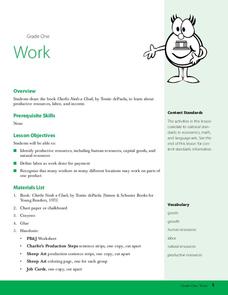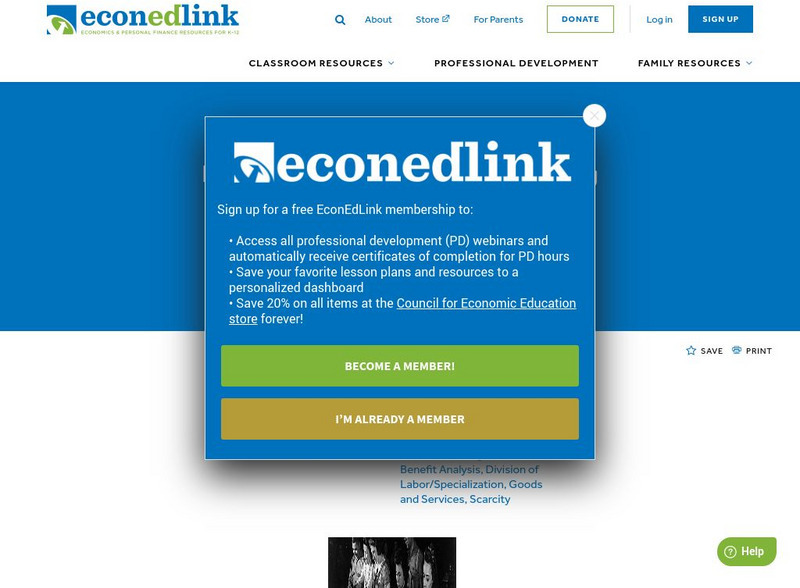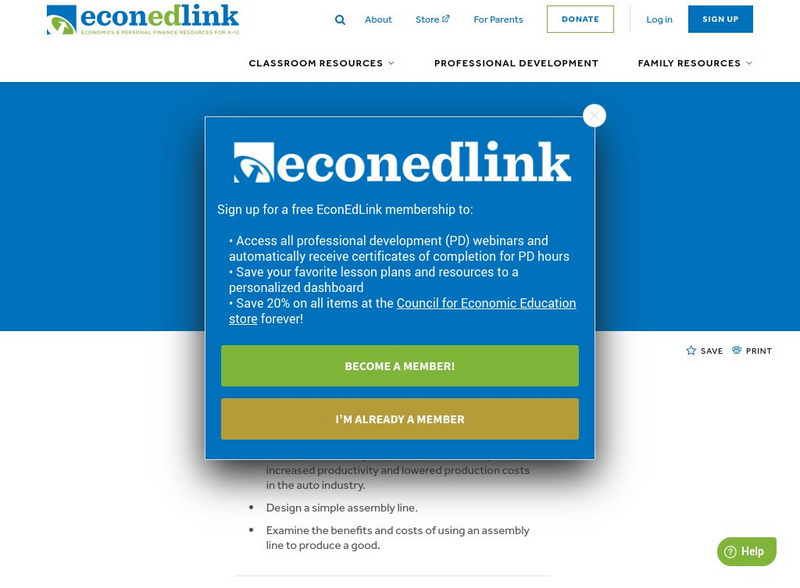Curated OER
Lemonade For Sale
2-3rd graders listen to the story, Lemonade for Sale, by Stuart J. Murphy. In the story, children produce and sell lemonade to raise money for their clubhouse, create a product, classify the resources used in production as natural...
Curated OER
Work
Students identify productive resources. In this economics instructional activity, students read the book Charlie Needs a Cloak and discuss productive resources the character used in the book. Students participate in a simulated factory...
Curated OER
Tortilla Factory
Students identify productive resources and intermediate goods used to produce corn tortillas. In this productive resources lesson, students listen to the book Tortilla Factory and classify resources used to make paper tacos.
Curated OER
The Goat in the Rug
Students define productive, capital, human and natural resources and intermediate goods, then classify these things by how they are used in a production process. In this resources/goods lesson plan, students listen to the story The Goat...
Council for Economic Education
Econ Ed Link: Lessons: Water, Water, Everywhere
Lesson that illustrates how people use water for transportation, farming, and fun. Students identify water as a natural resource and view images of the many ways that water can be used.
Council for Economic Education
Econ Ed Link: The Write Stuff
Right now you are probably using a pencil to do your school work. But do you know where the pencil came from, or how it is made? Did you know that the Star Spangled Banner, written by Francis Scott Key was first written in pencil? And...
Council for Economic Education
Econ Ed Link: Music, Maestro, Please: Show Business and the Factors of Production
The city of Philadelphia, Pennsylvania recently opened a $300 million dollar center for the performing arts, the Kimmel Center. This lesson was developed for a special teacher workshop to incorporate economics and the arts to teach kids...
Council for Economic Education
Econ Ed Link: Hey, Mom! What's for Breakfast?
In this lesson students working in cooperative groups will: 1.Discuss food items they consume for breakfast. 2.Investigate elements of foreign culture, particularly food. 3.Use map skills to locate selected foreign nations. 4.Increase...
Council for Economic Education
Econ Ed Link: Paraffin Alia
All resources are limited. It is this simple fact--scarcity--that forces us to make decisions. When we do make a choice, we pass up some other opportunity. Opportunity cost is defined as the next best alternative not chosen, or the...
Council for Economic Education
Econ Ed Link: Where's the Beef?
Students explore meat consumption statistics, an indicator of a nation's relative prosperity and standard of living. They do a survey of a family's meat consumption and compare their results to statistics from Colonial and modern- day...
Council for Economic Education
Econ Ed Link: A Fair Wage
Income for most people is determined by the market value of the productive resources they sell. What workers earn depends, primarily, on the market value of what they produce and how productive they are.
Council for Economic Education
Econ Ed Link: Booker T. Washington:"fifty Cents and a Dream"
Young Booker T. Washington had a dream. That dream was to use the resources at his disposal to earn the money necessary to get an education that would allow him and others to become financially secure. This lesson based on the picture...
Council for Economic Education
Econedlink: Economic Growth Video and Quiz
This video teaches the concept of Economic Growth. Economic growth refers to the ability of the economy to increase its total real output or real GDP, or its real output per person. The website contains an interactive quiz and links for...
Council for Economic Education
Econ Ed Link: Mystery Workers: Productive Resources
This website focuses on productive resources which are divided into three categories, natural, human, and capital.
Council for Economic Education
Econ Ed Link: Lean on Me We Depend on Each Other!
The purpose of this activity is to demonstrate that the production of most goods can be broken down into a number of specific tasks (division of labor), with each of these tasks assigned to specific workers (specialization.)
Council for Economic Education
Econ Ed Link: Economic Spotter: Resources During World War Ii
In World War II pennies were made of steel and zinc instead of copper and women were working at jobs that men had always been hired to do. Why? Because during war times, scarcity forces many things to change!
Council for Economic Education
Econ Ed Link: The Mystery of the Amazing Farmers
In this lesson plan, you will be taking on the role of an investigative reporter to solve the Amazing Farmer Mystery. The goal will be to use seven clues provided throughout the lesson plan in order to figure out how so few farmers can...
Council for Economic Education
Econ Ed Link: Henry Ford and the Model T: A Case Study in Productivity (Part 2)
Henry Ford's use of mass production strategies to manufacture the Model T revolutionized industrial manufacturing. This 3-part learning unit provides students with the story of Henry Ford and the Model T from an economics perspective....
Council for Economic Education
Econ Ed Link: Henry Ford and the Model T: A Case Study in Productivity (Part 1)
Henry Ford's use of mass production strategies to manufacture the Model T revolutionized industrial manufacturing. This 3-part learning unit provides students with the story of Henry Ford and the Model T from an economics perspective....












